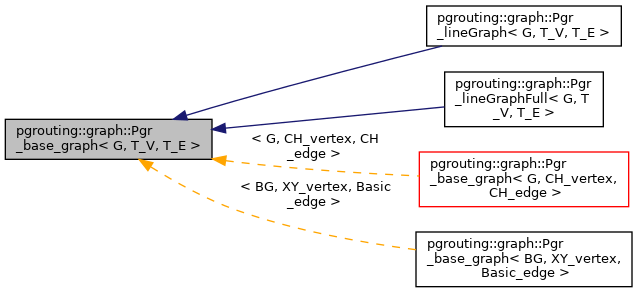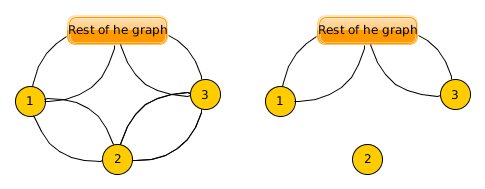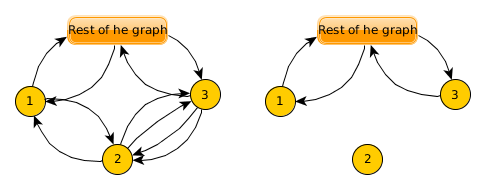 |
PGROUTING
3.2
|
 |
PGROUTING
3.2
|
#include "pgr_base_graph.hpp"


Graph related types | |||||||||||||||||||||||||
| |||||||||||||||||||||||||
| typedef G | B_G | ||||||||||||||||||||||||
| typedef T_E | G_T_E | ||||||||||||||||||||||||
| typedef T_V | G_T_V | ||||||||||||||||||||||||
| typedef boost::graph_traits< G >::vertex_descriptor | V | ||||||||||||||||||||||||
| typedef boost::graph_traits< G >::edge_descriptor | E | ||||||||||||||||||||||||
| typedef boost::graph_traits< G >::vertex_iterator | V_i | ||||||||||||||||||||||||
| typedef boost::graph_traits< G >::edge_iterator | E_i | ||||||||||||||||||||||||
| typedef boost::graph_traits< G >::out_edge_iterator | EO_i | ||||||||||||||||||||||||
| typedef boost::graph_traits< G >::in_edge_iterator | EI_i | ||||||||||||||||||||||||
| typedef boost::graph_traits< G >::vertices_size_type | vertices_size_type | ||||||||||||||||||||||||
| typedef boost::graph_traits< G >::edges_size_type | edges_size_type | ||||||||||||||||||||||||
| typedef boost::graph_traits< G >::degree_size_type | degree_size_type | ||||||||||||||||||||||||
The Graph | |
| G | graph |
| The graph. More... | |
| graphType | m_gType |
| type (DIRECTED or UNDIRECTED) More... | |
| Pgr_base_graph (const std::vector< T_V > &vertices, graphType gtype) | |
| Constructor. More... | |
| Pgr_base_graph (graphType gtype) | |
| Prepares the graph to be of type gtype with 0 vertices. More... | |
Id mapping handling | |
| typedef std::map< V, size_t > | IndexMap |
| id_to_V | vertices_map |
| id -> graph id More... | |
| boost::property_map< G, boost::vertex_index_t >::type | vertIndex |
| IndexMap | mapIndex |
| boost::associative_property_map< IndexMap > | propmapIndex |
Insert edges | |
| template<typename T > | |
| void | insert_edges (const T *edges, size_t count) |
| Inserts count edges of type T into the graph. More... | |
| template<typename T > | |
| void | insert_edges_neg (const T *edges, size_t count) |
| template<typename T > | |
| void | insert_edges (T *edges, size_t count, bool) |
| template<typename T > | |
| void | insert_negative_edges (const T *edges, int64_t count) |
| template<typename T > | |
| void | insert_edges (const std::vector< T > &edges, bool normal=true) |
| Inserts count edges of type pgr_edge_t into the graph The set of edges should not have an illegal vertex defined When the graph is empty calls: More... | |
| template<typename T > | |
| void | insert_min_edges_no_parallel (const T *edges, size_t count) |
| template<typename T > | |
| void | insert_min_edges_no_parallel (const std::vector< T > &edges) |
| template<typename T > | |
| void | insert_negative_edges (const std::vector< T > &edges, bool normal=true) |
| void | add_vertices (std::vector< T_V > vertices) |
| adds the vertices into the graph More... | |
only for stand by program | |
| int64_t | get_edge_id (V from, V to, double &distance) const |
| E | get_edge (V from, V to, double &distance) const |
| size_t | num_vertices () const |
| size_t | num_edges () const |
| void | graph_add_edge (const T_E &edge) |
| template<typename T > | |
| void | graph_add_edge (const T &edge, bool normal=true) |
| template<typename T > | |
| void | graph_add_min_edge_no_parallel (const T &edge) |
| template<typename T > | |
| void | graph_add_neg_edge (const T &edge, bool normal=true) |
| template<typename T > | |
| void | graph_add_edge_no_create_vertex (const T &edge) |
| Use this function when the vertices are already inserted in the graph. More... | |
| std::ostream & | operator<< (std::ostream &log, const Pgr_base_graph< G, T_V, T_E > &g) |
Definition at line 168 of file pgr_base_graph.hpp.
| typedef G pgrouting::graph::Pgr_base_graph< G, T_V, T_E >::B_G |
Definition at line 226 of file pgr_base_graph.hpp.
| typedef boost::graph_traits< G >::degree_size_type pgrouting::graph::Pgr_base_graph< G, T_V, T_E >::degree_size_type |
Definition at line 241 of file pgr_base_graph.hpp.
| typedef boost::graph_traits< G >::edge_descriptor pgrouting::graph::Pgr_base_graph< G, T_V, T_E >::E |
Definition at line 230 of file pgr_base_graph.hpp.
| typedef boost::graph_traits< G >::edge_iterator pgrouting::graph::Pgr_base_graph< G, T_V, T_E >::E_i |
Definition at line 232 of file pgr_base_graph.hpp.
| typedef boost::graph_traits< G >::edges_size_type pgrouting::graph::Pgr_base_graph< G, T_V, T_E >::edges_size_type |
Definition at line 239 of file pgr_base_graph.hpp.
| typedef boost::graph_traits< G >::in_edge_iterator pgrouting::graph::Pgr_base_graph< G, T_V, T_E >::EI_i |
Definition at line 234 of file pgr_base_graph.hpp.
| typedef boost::graph_traits< G >::out_edge_iterator pgrouting::graph::Pgr_base_graph< G, T_V, T_E >::EO_i |
Definition at line 233 of file pgr_base_graph.hpp.
| typedef T_E pgrouting::graph::Pgr_base_graph< G, T_V, T_E >::G_T_E |
Definition at line 227 of file pgr_base_graph.hpp.
| typedef T_V pgrouting::graph::Pgr_base_graph< G, T_V, T_E >::G_T_V |
Definition at line 228 of file pgr_base_graph.hpp.
| typedef std::map< int64_t, V > pgrouting::graph::Pgr_base_graph< G, T_V, T_E >::id_to_V |
Definition at line 253 of file pgr_base_graph.hpp.
| typedef std::map<V, size_t> pgrouting::graph::Pgr_base_graph< G, T_V, T_E >::IndexMap |
Definition at line 271 of file pgr_base_graph.hpp.
| typedef id_to_V::const_iterator pgrouting::graph::Pgr_base_graph< G, T_V, T_E >::LI |
Definition at line 254 of file pgr_base_graph.hpp.
| typedef boost::graph_traits< G >::vertex_descriptor pgrouting::graph::Pgr_base_graph< G, T_V, T_E >::V |
Definition at line 229 of file pgr_base_graph.hpp.
| typedef boost::graph_traits< G >::vertex_iterator pgrouting::graph::Pgr_base_graph< G, T_V, T_E >::V_i |
Definition at line 231 of file pgr_base_graph.hpp.
| typedef boost::graph_traits< G >::vertices_size_type pgrouting::graph::Pgr_base_graph< G, T_V, T_E >::vertices_size_type |
Definition at line 237 of file pgr_base_graph.hpp.
|
inline |
Constructor.
Definition at line 295 of file pgr_base_graph.hpp.
|
inlineexplicit |
Prepares the graph to be of type gtype with 0 vertices.
Definition at line 335 of file pgr_base_graph.hpp.
|
inlineprivate |
adds the vertices into the graph
PRECONDITIONS:
POSTCONDITIONS:
Example use:
Definition at line 462 of file pgr_base_graph.hpp.
Referenced by pgrouting::graph::Pgr_base_graph< BG, XY_vertex, Basic_edge >::insert_edges().
|
inline |
Definition at line 562 of file pgr_base_graph.hpp.
Referenced by pgrouting::alphashape::Pgr_alphaShape::make_triangles().
| void pgrouting::graph::Pgr_base_graph< G, T_V, T_E >::disconnect_edge | ( | int64_t | p_from, |
| int64_t | p_to | ||
| ) |
Disconnects all edges from p_from to p_to.


| [in] | p_from | original vertex id of the starting point of the edge |
| [in] | p_to | original vertex id of the ending point of the edge |
Definition at line 765 of file pgr_base_graph.hpp.
| void pgrouting::graph::Pgr_base_graph< G, T_V, T_E >::disconnect_out_going_edge | ( | int64_t | vertex_id, |
| int64_t | edge_id | ||
| ) |
Disconnects the outgoing edges of a vertex.
| [in] | vertex_id | original vertex |
| [in] | edge_id | original edge_id |
Definition at line 794 of file pgr_base_graph.hpp.
| void pgrouting::graph::Pgr_base_graph< G, T_V, T_E >::disconnect_vertex | ( | int64_t | p_vertex | ) |
Disconnects all incoming and outgoing edges from the vertex.
boost::graph doesn't recommend th to insert/remove vertices, so a vertex removal is simulated by disconnecting the vertex from the graph


| [in] | p_vertex | original vertex id of the starting point of the edge |
Definition at line 826 of file pgr_base_graph.hpp.
| void pgrouting::graph::Pgr_base_graph< G, T_V, T_E >::disconnect_vertex | ( | V | vertex | ) |
Definition at line 833 of file pgr_base_graph.hpp.
|
inline |
Definition at line 671 of file pgr_base_graph.hpp.
| int64_t pgrouting::graph::Pgr_base_graph< G, T_V, T_E >::get_edge_id | ( | V | from, |
| V | to, | ||
| double & | distance | ||
| ) | const |
Definition at line 878 of file pgr_base_graph.hpp.
|
inline |
get the vertex descriptor of the vertex When the vertex does not exist
Definition at line 512 of file pgr_base_graph.hpp.
Referenced by pgrouting::graph::Pgr_lineGraph< G, T_V, T_E >::graph_add_edge(), pgrouting::graph::Pgr_lineGraphFull< G, T_V, T_E >::graph_add_edge(), pgrouting::graph::Pgr_base_graph< BG, XY_vertex, Basic_edge >::graph_add_edge_no_create_vertex(), pgrouting::graph::Pgr_base_graph< BG, XY_vertex, Basic_edge >::in_degree(), and pgrouting::graph::Pgr_base_graph< BG, XY_vertex, Basic_edge >::out_degree().
|
inline |
get the vertex descriptor of the vid Call has_vertex(vid) before calling this function
Definition at line 528 of file pgr_base_graph.hpp.
| void pgrouting::graph::Pgr_base_graph< G, T_V, T_E >::graph_add_edge | ( | const T & | edge, |
| bool | normal = true |
||
| ) |
Definition at line 936 of file pgr_base_graph.hpp.
| void pgrouting::graph::Pgr_base_graph< G, T_V, T_E >::graph_add_edge | ( | const T_E & | edge | ) |
Definition at line 908 of file pgr_base_graph.hpp.
Referenced by pgrouting::graph::Pgr_base_graph< BG, XY_vertex, Basic_edge >::insert_edges().
|
inline |
Use this function when the vertices are already inserted in the graph.
Definition at line 721 of file pgr_base_graph.hpp.
Referenced by pgrouting::graph::Pgr_base_graph< BG, XY_vertex, Basic_edge >::insert_edges().
| void pgrouting::graph::Pgr_base_graph< G, T_V, T_E >::graph_add_min_edge_no_parallel | ( | const T & | edge | ) |
Definition at line 972 of file pgr_base_graph.hpp.
Referenced by pgrouting::graph::Pgr_base_graph< BG, XY_vertex, Basic_edge >::insert_min_edges_no_parallel().
| void pgrouting::graph::Pgr_base_graph< G, T_V, T_E >::graph_add_neg_edge | ( | const T & | edge, |
| bool | normal = true |
||
| ) |
Definition at line 1035 of file pgr_base_graph.hpp.
Referenced by pgrouting::graph::Pgr_base_graph< BG, XY_vertex, Basic_edge >::insert_negative_edges().
|
inline |
True when vid is in the graph.
Definition at line 534 of file pgr_base_graph.hpp.
Referenced by pgrouting::graph::Pgr_base_graph< BG, XY_vertex, Basic_edge >::add_vertices(), pgrouting::graph::Pgr_base_graph< BG, XY_vertex, Basic_edge >::get_V(), pgrouting::graph::Pgr_base_graph< BG, XY_vertex, Basic_edge >::graph_add_edge_no_create_vertex(), pgrouting::graph::Pgr_base_graph< BG, XY_vertex, Basic_edge >::in_degree(), pgrouting::graph::Pgr_base_graph< BG, XY_vertex, Basic_edge >::insert_edges(), pgrouting::graph::Pgr_base_graph< BG, XY_vertex, Basic_edge >::out_degree(), and pgrouting::graph::Pgr_base_graph< BG, XY_vertex, Basic_edge >::Pgr_base_graph().
|
inline |
Definition at line 497 of file pgr_base_graph.hpp.
Referenced by pgrouting::graph::Pgr_base_graph< BG, XY_vertex, Basic_edge >::in_degree().
|
inline |
in degree of a vertex
Definition at line 576 of file pgr_base_graph.hpp.
|
inline |
Inserts count edges of type pgr_edge_t into the graph The set of edges should not have an illegal vertex defined When the graph is empty calls:
| edges | |
| normal |
Definition at line 395 of file pgr_base_graph.hpp.
|
inline |
Inserts count edges of type T into the graph.
Converts the edges to a std::vector<T> & calls the overloaded twin function.
| edges | |
| count |
Definition at line 357 of file pgr_base_graph.hpp.
Referenced by do_pgr_articulationPoints(), do_pgr_astarManyToMany(), do_pgr_bdAstar(), do_pgr_bdDijkstra(), do_pgr_bellman_ford(), do_pgr_bellman_ford_neg(), do_pgr_biconnectedComponents(), do_pgr_binaryBreadthFirstSearch(), do_pgr_bipartite(), do_pgr_boyerMyrvold(), do_pgr_breadthFirstSearch(), do_pgr_bridges(), do_pgr_combinations_dijkstra(), do_pgr_connectedComponents(), do_pgr_dagShortestPath(), do_pgr_depthFirstSearch(), do_pgr_dijkstraVia(), do_pgr_driving_many_to_dist(), do_pgr_edwardMoore(), do_pgr_floydWarshall(), do_pgr_isPlanar(), do_pgr_johnson(), do_pgr_kruskal(), do_pgr_ksp(), do_pgr_LTDTree(), do_pgr_makeConnected(), do_pgr_many_to_many_dijkstra(), do_pgr_many_withPointsDD(), do_pgr_randomSpanningTree(), do_pgr_sequentialVertexColoring(), do_pgr_stoerWagner(), do_pgr_strongComponents(), do_pgr_topologicalSort(), do_pgr_transitiveClosure(), do_pgr_turnRestrictedPath(), do_pgr_withPoints(), do_pgr_withPointsKsp(), pgrouting::graph::Pgr_base_graph< BG, XY_vertex, Basic_edge >::insert_edges(), pgrouting::graph::Pgr_base_graph< BG, XY_vertex, Basic_edge >::insert_edges_neg(), pgrouting::graph::Pgr_base_graph< BG, XY_vertex, Basic_edge >::insert_min_edges_no_parallel(), and pgrouting::alphashape::Pgr_alphaShape::Pgr_alphaShape().
|
inline |
Definition at line 367 of file pgr_base_graph.hpp.
|
inline |
Definition at line 362 of file pgr_base_graph.hpp.
Referenced by do_pgr_lineGraph(), and do_pgr_lineGraphFull().
|
inline |
Definition at line 416 of file pgr_base_graph.hpp.
|
inline |
Definition at line 410 of file pgr_base_graph.hpp.
Referenced by do_pgr_prim().
|
inline |
Definition at line 423 of file pgr_base_graph.hpp.
|
inline |
Definition at line 376 of file pgr_base_graph.hpp.
Referenced by do_pgr_bellman_ford_neg(), and pgrouting::graph::Pgr_base_graph< BG, XY_vertex, Basic_edge >::insert_negative_edges().
|
inline |
Definition at line 543 of file pgr_base_graph.hpp.
Referenced by pgrouting::graph::Pgr_base_graph< BG, XY_vertex, Basic_edge >::graph_add_edge_no_create_vertex(), and pgrouting::graph::Pgr_base_graph< BG, XY_vertex, Basic_edge >::in_degree().
|
inline |
Definition at line 545 of file pgr_base_graph.hpp.
Referenced by pgrouting::graph::Pgr_base_graph< BG, XY_vertex, Basic_edge >::adjacent().
|
inline |
Definition at line 546 of file pgr_base_graph.hpp.
Referenced by pgrouting::graph::Pgr_base_graph< BG, XY_vertex, Basic_edge >::adjacent().
|
inline |
Definition at line 544 of file pgr_base_graph.hpp.
Referenced by pgrouting::graph::Pgr_base_graph< BG, XY_vertex, Basic_edge >::graph_add_edge_no_create_vertex().
|
inline |
Definition at line 704 of file pgr_base_graph.hpp.
Referenced by pgrouting::graph::Pgr_lineGraph< G, T_V, T_E >::graph_add_edge().
|
inline |
Definition at line 703 of file pgr_base_graph.hpp.
Referenced by pgrouting::graph::Pgr_lineGraph< G, T_V, T_E >::add_one_vertex(), pgrouting::graph::Pgr_base_graph< BG, XY_vertex, Basic_edge >::add_vertices(), pgrouting::graph::Pgr_base_graph< BG, XY_vertex, Basic_edge >::get_V(), pgrouting::graph::Pgr_base_graph< BG, XY_vertex, Basic_edge >::insert_edges(), and pgrouting::graph::Pgr_lineGraphFull< G, T_V, T_E >::insert_vertex().
|
inline |
Definition at line 554 of file pgr_base_graph.hpp.
|
inline |
Definition at line 555 of file pgr_base_graph.hpp.
|
inline |
Definition at line 557 of file pgr_base_graph.hpp.
|
inline |
Definition at line 558 of file pgr_base_graph.hpp.
|
inline |
get the out-degree of a vertex
| [in] | vertex_id | original vertex id |
Definition at line 489 of file pgr_base_graph.hpp.
Referenced by pgrouting::algorithms::bridges(), pgrouting::graph::Pgr_base_graph< BG, XY_vertex, Basic_edge >::in_degree(), and pgrouting::graph::Pgr_base_graph< BG, XY_vertex, Basic_edge >::out_degree().
|
inline |
out degree of a vertex
regardles of undirected or directed graph
Definition at line 587 of file pgr_base_graph.hpp.
| void pgrouting::graph::Pgr_base_graph< G, T_V, T_E >::restore_graph |
|
inline |
Definition at line 560 of file pgr_base_graph.hpp.
Referenced by pgrouting::graph::Pgr_base_graph< BG, XY_vertex, Basic_edge >::adjacent(), pgrouting::graph::Pgr_lineGraphFull< G, T_V, T_E >::apply_transformation(), pgrouting::graph::Pgr_base_graph< BG, XY_vertex, Basic_edge >::get_edge(), pgrouting::graph::Pgr_lineGraphFull< G, T_V, T_E >::get_postgres_results_directed(), pgrouting::graph::Pgr_lineGraph< G, T_V, T_E >::get_postgres_results_directed(), pgrouting::graph::Pgr_lineGraphFull< G, T_V, T_E >::graph_add_edge(), pgrouting::graph::Pgr_base_graph< BG, XY_vertex, Basic_edge >::insert_edges(), pgrouting::graph::Pgr_base_graph< BG, XY_vertex, Basic_edge >::is_source(), pgrouting::alphashape::Pgr_alphaShape::make_triangles(), and pgrouting::alphashape::Pgr_alphaShape::radius().
|
inline |
Definition at line 561 of file pgr_base_graph.hpp.
Referenced by pgrouting::graph::Pgr_base_graph< BG, XY_vertex, Basic_edge >::adjacent(), pgrouting::graph::Pgr_base_graph< BG, XY_vertex, Basic_edge >::get_edge(), pgrouting::graph::Pgr_lineGraphFull< G, T_V, T_E >::get_postgres_results_directed(), pgrouting::graph::Pgr_lineGraph< G, T_V, T_E >::get_postgres_results_directed(), pgrouting::graph::Pgr_lineGraphFull< G, T_V, T_E >::graph_add_edge(), pgrouting::graph::Pgr_base_graph< BG, XY_vertex, Basic_edge >::insert_edges(), pgrouting::graph::Pgr_base_graph< BG, XY_vertex, Basic_edge >::is_target(), pgrouting::alphashape::Pgr_alphaShape::make_triangles(), and pgrouting::alphashape::Pgr_alphaShape::radius().
|
friend |
Definition at line 645 of file pgr_base_graph.hpp.
| G pgrouting::graph::Pgr_base_graph< G, T_V, T_E >::graph |
The graph.
Definition at line 260 of file pgr_base_graph.hpp.
Referenced by pgrouting::graph::Pgr_lineGraph< G, T_V, T_E >::add_one_vertex(), pgrouting::graph::Pgr_base_graph< BG, XY_vertex, Basic_edge >::add_vertices(), pgrouting::graph::Pgr_lineGraphFull< G, T_V, T_E >::apply_transformation(), pgrouting::algorithms::articulationPoints(), pgrouting::algorithms::biconnectedComponents(), pgrouting::algorithms::bridges(), pgrouting::graph::Pgr_lineGraph< G, T_V, T_E >::create_edges(), pgrouting::graph::Pgr_base_graph< BG, XY_vertex, Basic_edge >::get_edge(), pgrouting::graph::Pgr_lineGraphFull< G, T_V, T_E >::get_postgres_results_directed(), pgrouting::graph::Pgr_lineGraph< G, T_V, T_E >::get_postgres_results_directed(), pgrouting::graph::Pgr_base_graph< BG, XY_vertex, Basic_edge >::get_V(), pgrouting::graph::Pgr_lineGraph< G, T_V, T_E >::graph_add_edge(), pgrouting::graph::Pgr_lineGraphFull< G, T_V, T_E >::graph_add_edge(), pgrouting::graph::Pgr_base_graph< BG, XY_vertex, Basic_edge >::graph_add_edge_no_create_vertex(), pgrouting::graph::Pgr_base_graph< BG, XY_vertex, Basic_edge >::in_degree(), pgrouting::graph::Pgr_lineGraphFull< G, T_V, T_E >::insert_vertex(), pgrouting::graph::Pgr_lineGraph< G, T_V, T_E >::insert_vertices(), pgrouting::alphashape::Pgr_alphaShape::make_triangles(), pgrouting::graph::Pgr_base_graph< BG, XY_vertex, Basic_edge >::num_edges(), pgrouting::graph::Pgr_base_graph< BG, XY_vertex, Basic_edge >::num_vertices(), pgrouting::alphashape::Pgr_alphaShape::operator()(), pgrouting::graph::Pgr_base_graph< BG, XY_vertex, Basic_edge >::operator[](), pgrouting::graph::Pgr_base_graph< BG, XY_vertex, Basic_edge >::out_degree(), pgrouting::graph::Pgr_base_graph< BG, XY_vertex, Basic_edge >::Pgr_base_graph(), pgrouting::algorithms::pgr_connectedComponents(), pgrouting::graph::Pgr_base_graph< BG, XY_vertex, Basic_edge >::source(), pgrouting::graph::Pgr_lineGraphFull< G, T_V, T_E >::store_edge_costs(), pgrouting::algorithms::strongComponents(), and pgrouting::graph::Pgr_base_graph< BG, XY_vertex, Basic_edge >::target().
| graphType pgrouting::graph::Pgr_base_graph< G, T_V, T_E >::m_gType |
type (DIRECTED or UNDIRECTED)
Definition at line 261 of file pgr_base_graph.hpp.
Referenced by pgrouting::graph::Pgr_base_graph< BG, XY_vertex, Basic_edge >::is_directed(), and pgrouting::graph::Pgr_base_graph< BG, XY_vertex, Basic_edge >::is_undirected().
| IndexMap pgrouting::graph::Pgr_base_graph< G, T_V, T_E >::mapIndex |
Definition at line 272 of file pgr_base_graph.hpp.
| boost::associative_property_map<IndexMap> pgrouting::graph::Pgr_base_graph< G, T_V, T_E >::propmapIndex |
Definition at line 273 of file pgr_base_graph.hpp.
Referenced by pgrouting::graph::Pgr_base_graph< BG, XY_vertex, Basic_edge >::get_V().
| std::deque< T_E > pgrouting::graph::Pgr_base_graph< G, T_V, T_E >::removed_edges |
Used for storing the removed_edges.
Definition at line 281 of file pgr_base_graph.hpp.
| id_to_V pgrouting::graph::Pgr_base_graph< G, T_V, T_E >::vertices_map |
id -> graph id
Definition at line 267 of file pgr_base_graph.hpp.
Referenced by pgrouting::graph::Pgr_lineGraph< G, T_V, T_E >::add_one_vertex(), pgrouting::graph::Pgr_base_graph< BG, XY_vertex, Basic_edge >::add_vertices(), pgrouting::graph::Pgr_base_graph< BG, XY_vertex, Basic_edge >::get_V(), pgrouting::graph::Pgr_lineGraphFull< G, T_V, T_E >::graph_add_edge(), pgrouting::graph::Pgr_base_graph< BG, XY_vertex, Basic_edge >::graph_add_edge_no_create_vertex(), pgrouting::graph::Pgr_base_graph< BG, XY_vertex, Basic_edge >::has_vertex(), pgrouting::graph::Pgr_lineGraphFull< G, T_V, T_E >::insert_vertex(), and pgrouting::graph::Pgr_base_graph< BG, XY_vertex, Basic_edge >::Pgr_base_graph().
| boost::property_map<G, boost::vertex_index_t>::type pgrouting::graph::Pgr_base_graph< G, T_V, T_E >::vertIndex |
Definition at line 269 of file pgr_base_graph.hpp.
Referenced by pgrouting::graph::Pgr_base_graph< BG, XY_vertex, Basic_edge >::Pgr_base_graph().